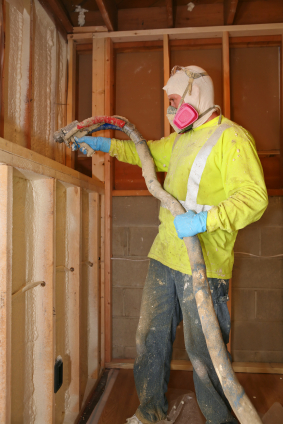 The most important first decision is how you want to insulate. There are many options. A basement can be a cold damp place without the proper insulation. Traditionally, a 2×4 stud wall is built on the inside of the foundation and then filled with batt insulation. A vapor barrier of plastic is then fitted over top of the studs. While this is a good method of insulating, it does have some drawbacks. Condensation is a big one. Even a small nail hole in the plastic will lead to a mixture of warm inside air and cold outside air. This can form condensation on the plastic, just like a cold pitcher of water on a hot summer day. This condensation over time can form mold and damage the studs and drywall.
The most important first decision is how you want to insulate. There are many options. A basement can be a cold damp place without the proper insulation. Traditionally, a 2×4 stud wall is built on the inside of the foundation and then filled with batt insulation. A vapor barrier of plastic is then fitted over top of the studs. While this is a good method of insulating, it does have some drawbacks. Condensation is a big one. Even a small nail hole in the plastic will lead to a mixture of warm inside air and cold outside air. This can form condensation on the plastic, just like a cold pitcher of water on a hot summer day. This condensation over time can form mold and damage the studs and drywall.
Styrofoam is becoming more popular. Sheets of 2″ styro foam are glued directly to the inside of the foundation. Joints are shiplapped and are sealed with insulating tape. While this method is slightly more expensive, it leads to a much better vapor barrier. In addition, the insulation goes from floor to ceiling without breaks in between. With the batt insulation, the insulation is only placed between the studs. Cold can still travel through the studs. With the Styrofoam option, the insulation is continuous without any breaks.
A third method of insulation is spray foam. This is the most expensive. It’s great for getting into tight places to ensure a bullet proof seal. This method accomplishes the same thing as the Styrofoam sheets, a tight vapor barrier between inside and outside air.
The final thing to consider insulating your basement is the floor. Often overlooked, without insulation it can be very cold in the winter time. Consider an insulated subfloor. This will greatly increase the comfort level in your basement.
